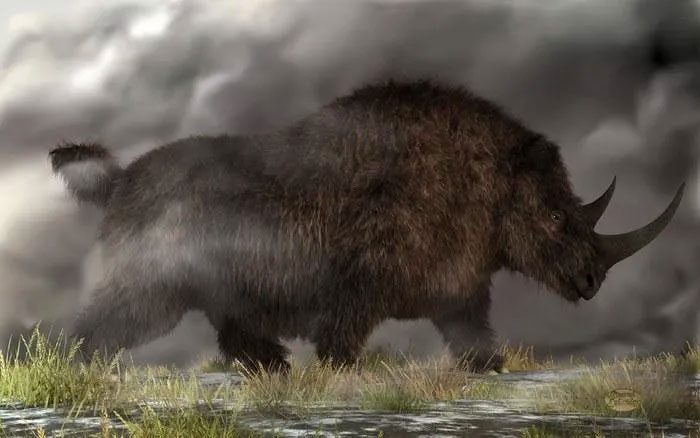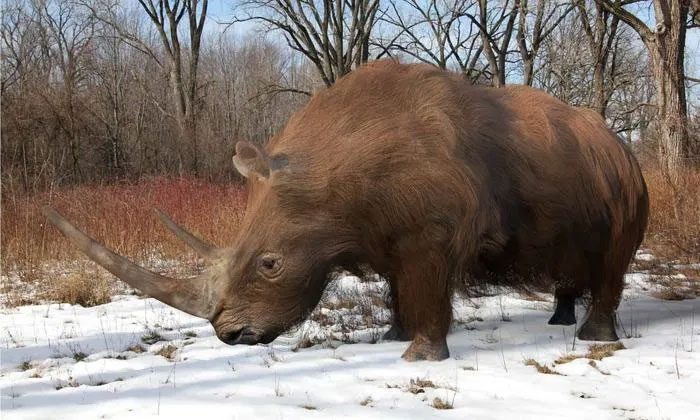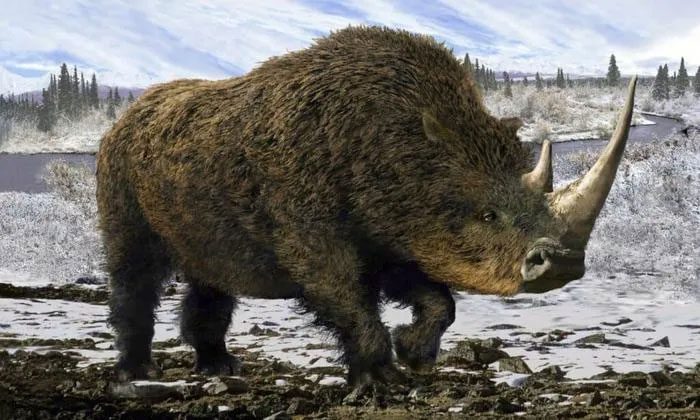Unlike the rhinoceroses we see today, the woolly rhinoceros had a thick, shaggy coat covering its entire body. This was likely due to their adaptation to extremely cold environments—though some also lived in grasslands.
The woolly rhinoceros, or Coelodonta antiquitatis, is a large species of rhinoceros that inhabited the Eurasian continent during the Pleistocene epoch. The earliest woolly rhinoceros fossils were discovered in the Tibetan region.
Recently, experts have clarified that this species went extinct due to climate change rather than hunting, as was previously believed. Their thick, long fur made them intolerant to high temperatures. As the Ice Age came to an end, their habitats disappeared as well. Consequently, these animals migrated from the Tibetan Plateau to colder areas around the world.

The woolly rhinoceros (Coelodonta antiquitatis) closely resembles modern rhinoceroses. Like modern African rhinoceroses, they also had a pair of horns, a larger horn at the front and a smaller one between their eyes. However, unlike modern rhinoceroses, they had much more fur, with longer heads and bodies, and shorter legs. The woolly rhinoceros also had a large hump behind its shoulders.
The woolly rhinoceros is one of the Ice Age mammals depicted in ancient cave paintings. It resembles modern rhinoceroses but had a more robust body with shorter legs and larger front horns than hind horns.
Male woolly rhinoceroses had larger horns than females, making them more attractive to mates during the breeding season. Previously, archaeologists had discovered numerous fossils of woolly rhinoceros horns with wear marks, leading many to believe that these animals used their horns to scrape snow and dig in the ground for food.
The fossils found of the woolly rhinoceros suggest it measured between 3 to 3.8 meters in length. They stood about two meters tall from foot to shoulder and weighed around three tons. The physical characteristics of this ancient rhinoceros provided them with the necessary adaptations for survival in icy environments.

Before going extinct about 14,000 years ago, the woolly rhinoceros roamed widely. Its fossils have been found in Spain, Siberia, and Korea. Thus, the woolly rhinoceros sometimes appears in ancient cave paintings—though not as frequently as mammoths or aurochs.
The woolly rhinoceros was a herbivore, similar to modern rhinoceroses. However, there is some debate regarding its diet. Investigations suggest they may have consumed grasses and other low-lying vegetation. It is believed that woolly rhinoceroses particularly favored leaves, moss, grass, and dense shrubs.
However, skull, jawbone, and tooth fossils from a woolly rhinoceros in Staffordshire show muscle and dental characteristics that are almost similar to those of modern herbivores. Another piece of evidence is the expansion of the temporalis and neck muscles of this species, which allowed them to pull grass forcefully from the ground. Regarding their living habits, many speculate that they were very similar to modern rhinoceroses, often wandering alone or living in small herds consisting of a mother and her young.

In 2020, locals in East Siberia accidentally discovered the frozen remains of a young woolly rhinoceros in melting ice. The permafrost preserved its intestines, fur, and even its horns. However, so far, no one has mentioned attempts to recreate and revive the woolly rhinoceros, as some have sought to do with the woolly mammoth.
Using the age of sediment layers that formed the fossils, researchers estimate that the woolly rhinoceros lived about 3.7 million years ago. This demonstrates the presence of this rhinoceros species on the Tibetan Plateau before it was found in the tundra of northeastern Siberia.
For many years, humans were considered the culprits behind the extinction of the woolly rhinoceros. Many believed that when humans began to inhabit Siberia, the rhinoceroses could not coexist as they hunted them. Humans and these rhinoceroses “competed” for about 16,000 years. However, recent evidence has disproven this.
After analyzing DNA samples, scientists concluded that climate change was the primary cause of the woolly rhinoceros’s extinction. The presence of humans did not significantly reduce the population of this species. Instead, scientists found that extinction began occurring from 18,500 to 14,000 years ago when the world experienced rapid warming.
This does not mean that humans did not hunt rhinoceroses. It simply means they were not directly responsible for the extinction of this species. Indirectly, humans may have contributed to the warmer climate, leading to the demise of the rhinoceros.

















































